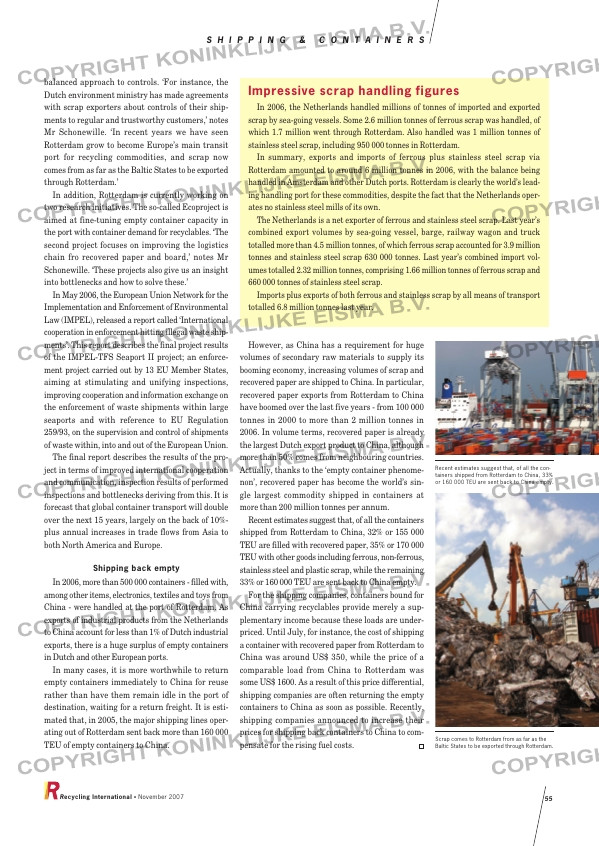Page 55 from: November 2007

balanced approach to controls. ‘For instance, the
Dutch environment ministry has made agreements
with scrap exporters about controls of their ship-
ments to regular and trustworthy customers,’ notes
Mr Schonewille. ‘In recent years we have seen
Rotterdam grow to become Europe’s main transit
port for recycling commodities, and scrap now
comes from as far as the Baltic States to be exported
through Rotterdam.’
In addition, Rotterdam is currently working on
two research initiatives. The so-called Ecoproject is
aimed at fine-tuning empty container capacity in
the port with container demand for recyclables. ‘The
second project focuses on improving the logistics
chain fro recovered paper and board,’ notes Mr
Schonewille. ‘These projects also give us an insight
into bottlenecks and how to solve these.’
In May 2006, the European Union Network for the
Implementation and Enforcement of Environmental
Law (IMPEL), released a report called ‘International
cooperation in enforcement hitting illegal waste ship-
ments’. This report describes the final project results
of the IMPEL-TFS Seaport II project; an enforce-
ment project carried out by 13 EU Member States,
aiming at stimulating and unifying inspections,
improving cooperation and information exchange on
the enforcement of waste shipments within large
seaports and with reference to EU Regulation
259/93, on the supervision and control of shipments
of waste within, into and out of the European Union.
The final report describes the results of the pro-
ject in terms of improved international cooperation
and communication, inspection results of performed
inspections and bottlenecks deriving from this. It is
forecast that global container transport will double
over the next 15 years, largely on the back of 10%-
plus annual increases in trade flows from Asia to
both North America and Europe.
Shipping back empty
In 2006, more than 500 000 containers – filled with,
among other items, electronics, textiles and toys from
China – were handled at the port of Rotterdam. As
exports of industrial products from the Netherlands
to China account for less than 1% of Dutch industrial
exports, there is a huge surplus of empty containers
in Dutch and other European ports.
In many cases, it is more worthwhile to return
empty containers immediately to China for reuse
rather than have them remain idle in the port of
destination, waiting for a return freight. It is esti-
mated that, in 2005, the major shipping lines oper-
ating out of Rotterdam sent back more than 160 000
TEU of empty containers to China.
However, as China has a requirement for huge
volumes of secondary raw materials to supply its
booming economy, increasing volumes of scrap and
recovered paper are shipped to China. In particular,
recovered paper exports from Rotterdam to China
have boomed over the last five years – from 100 000
tonnes in 2000 to more than 2 million tonnes in
2006. In volume terms, recovered paper is already
the largest Dutch export product to China, although
more than 50% comes from neighbouring countries.
Actually, thanks to the ‘empty container phenome-
non’, recovered paper has become the world’s sin-
gle largest commodity shipped in containers at
more than 200 million tonnes per annum.
Recent estimates suggest that, of all the containers
shipped from Rotterdam to China, 32% or 155 000
TEU are filled with recovered paper, 35% or 170 000
TEU with other goods including ferrous, non-ferrous,
stainless steel and plastic scrap, while the remaining
33% or 160 000 TEU are sent back to China empty.
For the shipping companies, containers bound for
China carrying recyclables provide merely a sup-
plementary income because these loads are under-
priced. Until July, for instance, the cost of shipping
a container with recovered paper from Rotterdam to
China was around US$ 350, while the price of a
comparable load from China to Rotterdam was
some US$ 1600. As a result of this price differential,
shipping companies are often returning the empty
containers to China as soon as possible. Recently,
shipping companies announced to increase their
prices for shipping back containers to China to com-
pensate for the rising fuel costs.
S H I P P I N G & C O N T A I N E R S
Recycling International • November 2007 55
Impressive scrap handling figures
In 2006, the Netherlands handled millions of tonnes of imported and exported
scrap by sea-going vessels. Some 2.6 million tonnes of ferrous scrap was handled, of
which 1.7 million went through Rotterdam. Also handled was 1 million tonnes of
stainless steel scrap, including 950 000 tonnes in Rotterdam.
In summary, exports and imports of ferrous plus stainless steel scrap via
Rotterdam amounted to around 6 million tonnes in 2006, with the balance being
handled in Amsterdam and other Dutch ports. Rotterdam is clearly the world’s lead-
ing handling port for these commodities, despite the fact that the Netherlands oper-
ates no stainless steel mills of its own.
The Netherlands is a net exporter of ferrous and stainless steel scrap. Last year’s
combined export volumes by sea-going vessel, barge, railway wagon and truck
totalled more than 4.5 million tonnes, of which ferrous scrap accounted for 3.9 million
tonnes and stainless steel scrap 630 000 tonnes. Last year’s combined import vol-
umes totalled 2.32 million tonnes, comprising 1.66 million tonnes of ferrous scrap and
660 000 tonnes of stainless steel scrap.
Imports plus exports of both ferrous and stainless scrap by all means of transport
totalled 6.8 million tonnes last year.
Recent estimates suggest that, of all the con-
tainers shipped from Rotterdam to China, 33%
or 160 000 TEU are sent back to China empty.
Scrap comes to Rotterdam from as far as the
Baltic States to be exported through Rotterdam.
RI_015 Rotterdam:Opmaak 1 08-11-2007 09:44 Pagina 55



